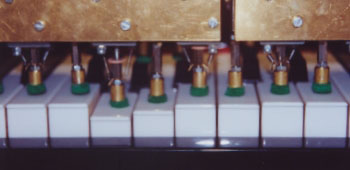Paper at Sound and Music Computing 2011 - SMC2011
Autoklavierspieler Overview
Robot Piano Player - Autoklavierspieler
Invention and construction by Winfried Ritsch designed for extreme piano performances.
- some selected Performances
- history and related projects
- development - Entwicklung
- Images and Media
- Open hardware and Software on github
First prototype: "Kantor" |
2002 Atelier Algorythmics |
|
The first version of the Autoklavierspieler was constructed 2002 after unsuccessfully attempts to use available player pianos. As a artistic research on robotic electromechanical instruments for extreme performances, the main target was the realisation of algorithmic compositions for 88 finger. The initial project was interpreting audio recordings on the piano for the series "Quadraturen III" of Peter Ablinger, using special transformation software developed on the IEM. (first recorded example) World première performance at Minoriten for dedicated works, especially composed for the robot piano player "Kantor". |
First Prototype for "Kantor" |
Second Generation: Millitron |
2004 Atelier Algorythmics |
|
With the need of dialogs and more performances in Europe a new Autoklavierspieler was needed, especially for the "Stadtoper" from Peter Ablinger. "Millitron", as this series is called, has half the weight, but with new electronics, algopic and algofet, it played more precise, especially quiet pieces and therefore had more piano-forte dynamics. (Example Video) |
"millitron" at stage |
Third Generation: Rhea |
at ars electronica 2012 |
|
Rhea was developed with the focus on easy transportation and fast setup. Also new electronics should enable much finer calibration and faster reaction failures on cheap pianos. Furthermore Rhea should be a first series for distribution, enabling others to control the piano, not only his creator. Therefore documentation will be enhanced and open source software released |
Additional Information
Sound and Music Computing Conference Paper 2011
"for a futurist poet, there is nothing more interesting than the movements of the keys of a player piano"
"Für einen futuristischen Dichter gibt es nichts Interessanteres als die Bewegungen der Tasten eines mechanischen Klaviers"
(F.T.Marinetti, 1912)

